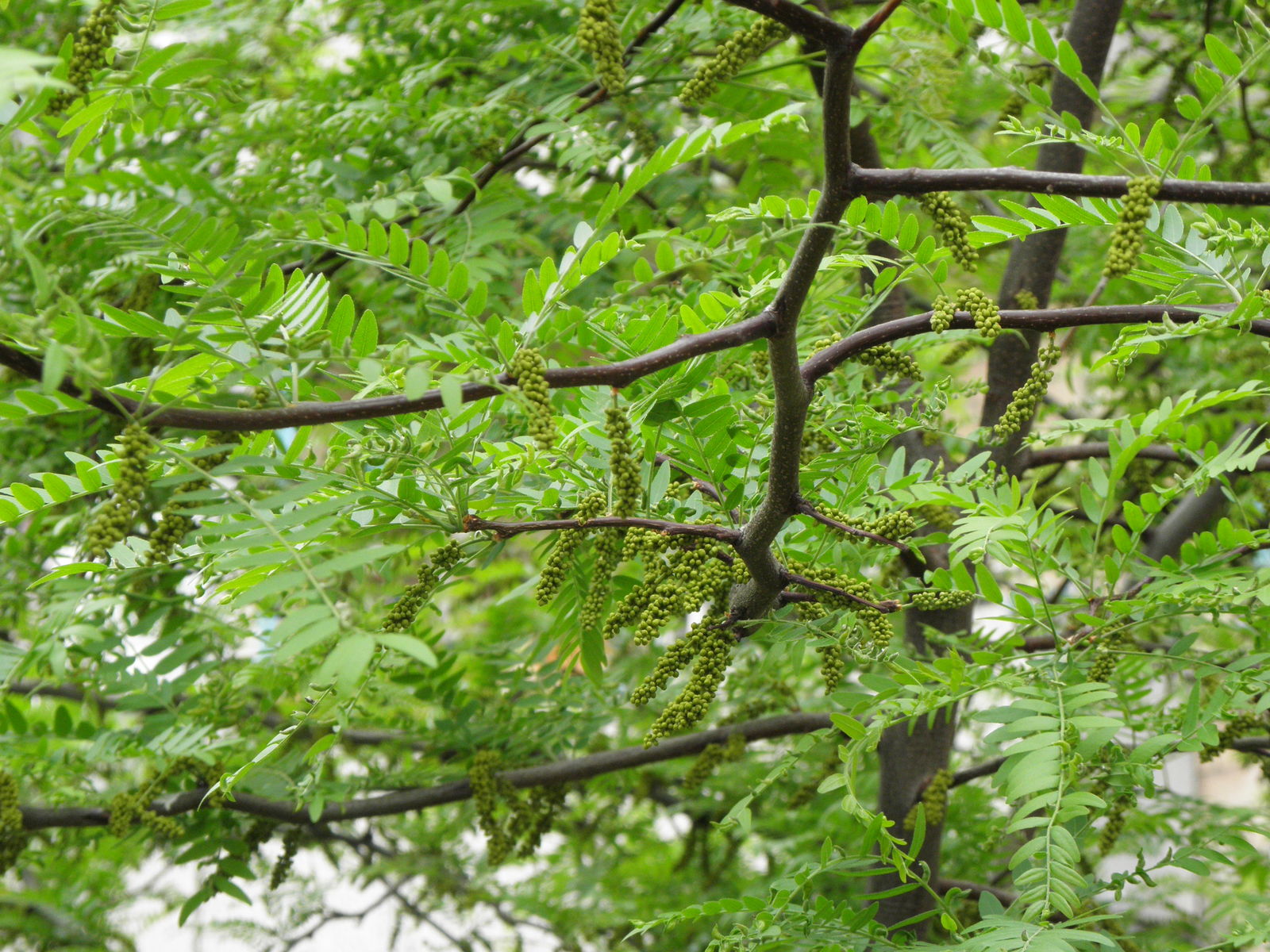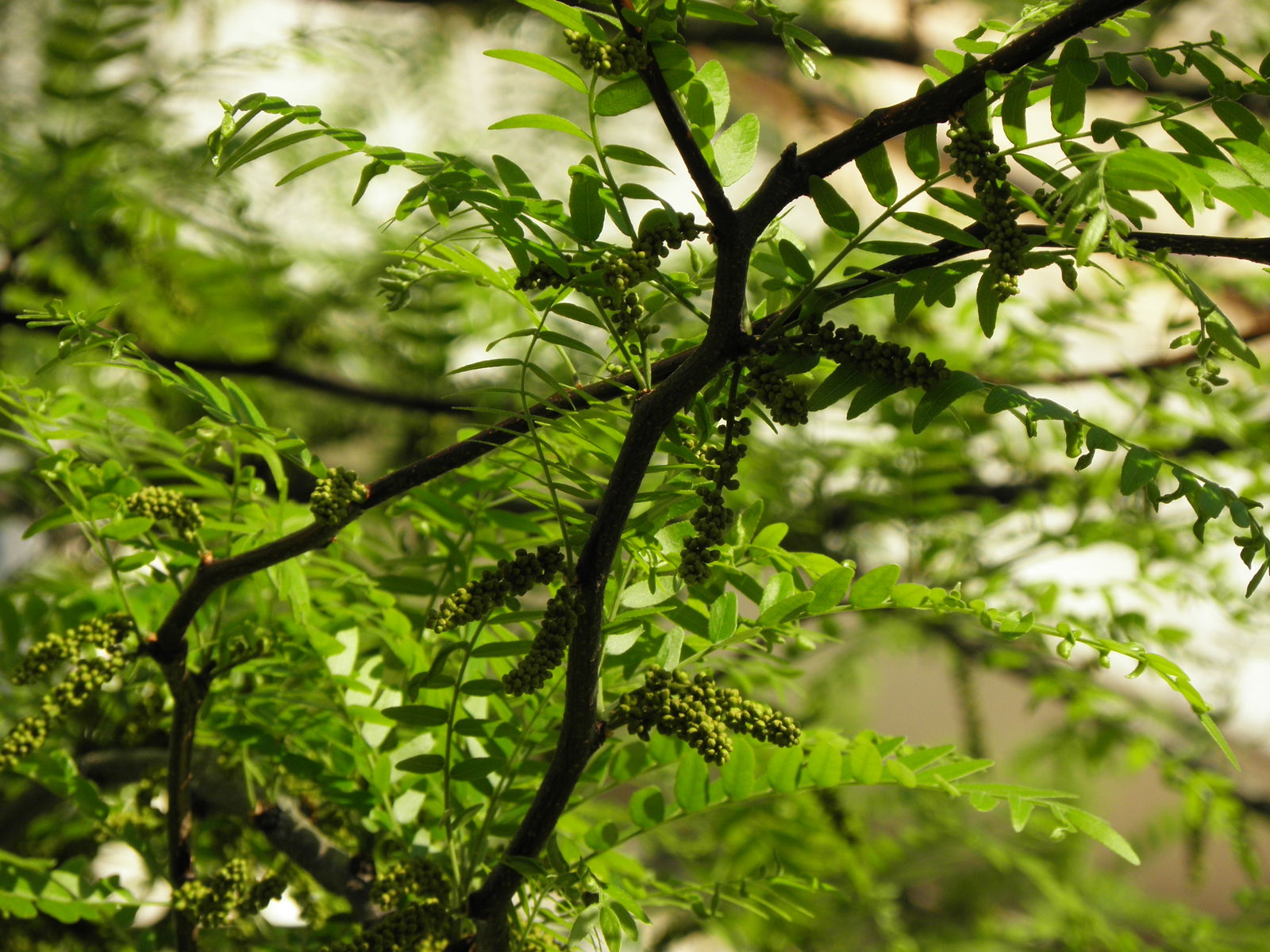Honey locust
gleditsia triacanthos
Also known as: ["Honey-shed thorn","Honey locust tree","Sweet locust"]
Overview
A deciduous tree native to North America, known for its bipinnate leaves, large thorns, and long, twisted seed pods filled with sweet, edible pulp.
Benefits & Perks
["long-flowering","disease resistant","deer resistant","wildlife attractant (bees, butterflies, birds)","shade tolerant"]
Botanical Classification
| Phylum: | Magnoliophyta |
| Class: | Magnoliopsida |
| Order: | Fabales |
| Family: | Fabaceae |
| Genus: | Gleditsia |
| Botanical Name: | Gleditsia triacanthos |
Plant Characteristics
Basic Information
- Category: Trees
- Suitable Location: large outdoor space, such as a park or spacious garden
- Suitable For:
- Is Weed: No
- Allergenicity: low
Environmental Needs
- Climate: {"temperatureRange":"–30–40°C"}
- Hardiness: {"zones":"3–9"}
- Misting: rarely required
- Drainage: Moderate to fast-draining; tolerates some clay but may struggle in poorly drained sites.
- Soil Type: Adaptable to various soils but prefers loamy, well-drained soil with organic matter.
Maintenance Level
- Maintenance Level: moderate
- Toughness Level: high
- Pruning Frequency: Annually in late winter or early spring; light pruning as needed after flowering.
- Pruning Intensity: Moderate; remove up to 25% of growth if necessary for health or shape.
Care Details
Ideal Sunlight Coverage:
Full sun (6–8 hours of direct sunlight daily); tolerates partial shade but may produce fewer pods.
Sunlight Tolerance Tips:
Acclimate young trees gradually to full sun; protect from intense midday sun in hot climates; ensure adequate spacing for light penetration.
Care Requirements
Care Difficulty
moderatemoderate
Sunlight
full sun
Full sun is best; avoid deep shade; rotate young trees for even growth.
Watering
every 2–3 weeks during dry periods, more frequently in extreme heat
Water thoroughly until runoff, allow soil to dry between waterings, avoid overwatering especially in winter.
Soil
deep, fertile, well-drained loam
pH: Adaptable pH range (6.0–7.5); tolerates slightly alkaline soils.
Ensure good drainage; amend with organic matter; avoid waterlogged conditions.
Temperature
Hardy in USDA zones 4–9; tolerates temperatures from -30°F to 100°F; prefers temperate climates with cold winters and warm summers.
Mulch for winter protection; water during heatwaves; avoid planting in frost pockets.
Fertilizing
annually in early spring with a balanced slow-release fertilizer
Fertilize only if growth is poor; avoid over-fertilization; test soil before applying.
Propagation
Methods
Seed or root cuttings; seeds require scarification or stratification for germination.
Step-by-Step Propagation Guide
- Seeds: scarify, stratify, sow.
- Root cuttings: select healthy roots, cut, plant horizontally, keep moist.
Best Time: Spring for seeds (after stratification); late summer for root cuttings.
Environment
Warm (70–80°F), high humidity (70–80%), partial shade for root cuttings.
Medium
Seed: well-drained soil mix; Root cuttings: moist perlite or sand.
Hormone
Not necessary for seeds; rooting hormone can aid root cuttings.
Timeline
Seeds: 1–3 months for germination; Root cuttings: 4–8 weeks for roots, 1–2 years to establish.
Tools Needed
Pruners, rooting hormone, pots, well-draining medium.
Quick Tips
Scarify seeds before planting; keep cuttings consistently moist; use bottom heat for faster rooting.
Pruning & Repotting
Pruning Guide
Method
Thinning cuts to open canopy; heading cuts to encourage branching; remove suckers at base.
Pruning Plan
Remove dead or crossing branches; shape for structural integrity; reduce wind resistance.
Tools
Loppers, pruning saw, hand pruners, gloves.
Checklist
Sterilize tools; prune during dormancy; make clean cuts; remove debris after pruning.
Repotting Guide
Best Season
Late winter or early spring before active growth begins.
Pot Size
For containers: one size up; for field-grown: maintain root ball integrity.
Method
For container-grown: use well-draining soil, minimal root disturbance; for field-grown: dig wide trench, prune damaged roots.
Suggestions
Not typically repotted; field-grown trees are transplanted bare-root or balled-and-burlapped.
Checklist
Prepare new site/ pot; prune damaged roots; backfill with amended soil; water thoroughly.
Advanced Care Tips
Watering Mastery
Watering Checklist
Check soil moisture before watering; water deeply; ensure proper drainage; adjust frequency by season.
How to Apply Water Properly
Water at the base of the plant, ensuring moisture reaches the root zone; water early in the morning to minimize evaporation; ensure excess water drains away to prevent root rot.
Watering Schedule Tips
Water deeply once a week during the growing season; reduce frequency in winter to once every 3–4 weeks unless soil is dry.
Soil Improvement
Add compost or aged manure for organic matter; incorporate sand or perlite for drainage in heavy soils.
Temperature Stress Management
Signs of Temperature Issues
Leaf scorch in excessive heat; dieback in prolonged cold without protection; reduced growth in overly mild winters.
Cold Stress
Leaves may drop prematurely; branches can die back if temperatures drop below hardiness zone limits; root damage in poorly drained soil during freeze.
Solution: Mulch heavily around the base in winter; avoid planting in low-lying areas prone to frost; protect young trees with burlap screens in extreme cold.
Hot Stress
Wilting during heatwaves; leaf drop; reduced flowering and pod production; increased susceptibility to pests.
Solution: Provide supplemental water during drought; use shade cloth in extreme heat; mulch to retain soil moisture.
Fertilizing Guide
Fertilizing Checklist
Test soil pH; apply fertilizer in spring; water after fertilizing; avoid late-season feeding.
Fertilizing Method
Use a balanced slow-release fertilizer in early spring; avoid high-nitrogen fertilizers to prevent excessive leafy growth; do not fertilize in late fall to avoid new growth vulnerable to frost.
Common Problems & Solutions
Toxicity Warning
Cats
Slightly ToxicCats may experience mild gastrointestinal upset if they ingest the seeds or pods of Gleditsia triacanthos. The toxic compounds in these parts can cause irritation to the digestive system, though severe reactions are rare.
⚠️ Symptoms:
🌿 Toxic Parts:
⚡ Toxic If:
if eaten
Dogs
Slightly ToxicIn dogs, ingestion of the seeds or pods of Gleditsia triacanthos can lead to mild gastrointestinal upset. The plant contains saponins and other irritants that may cause discomfort but are generally not life-threatening.
⚠️ Symptoms:
🌿 Toxic Parts:
⚡ Toxic If:
if eaten
Humans
Slightly ToxicGleditsia triacanthos, commonly known as the honey locust, contains compounds that can cause mild gastrointestinal distress if ingested. The seeds and pods are the primary toxic parts, containing saponins and other compounds that may irritate the digestive tract.
⚠️ Symptoms:
🌿 Toxic Parts:
⚡ Toxic If:
if eaten
Frequently Asked Questions
Q: Is the Honey locust tree toxic to pets?
A: No, the Honey locust is non-toxic to dogs and cats.
Q: Does the Honey locust produce edible parts?
A: Yes, its seed pods contain sweet, edible pulp.
Q: Is the Honey locust suitable for urban environments?
A: Yes, it is highly tolerant of urban conditions and pollution.
Quick Reference
| Family: | Fabaceae |
| Care: | moderate |
| Light: | full sun |
| Water: | every 2–3 weeks during dry p |
Get Expert Care Tips
Download the Plantious app for personalized care reminders and plant identification!
Google Play App Store








